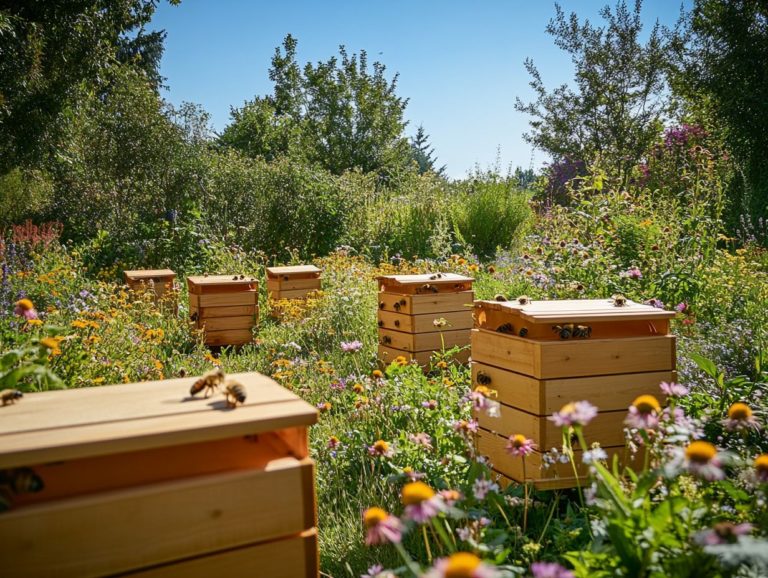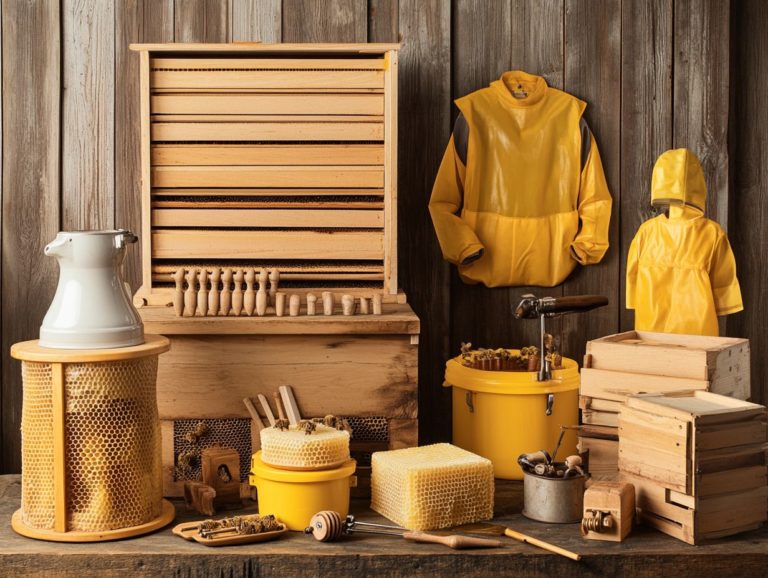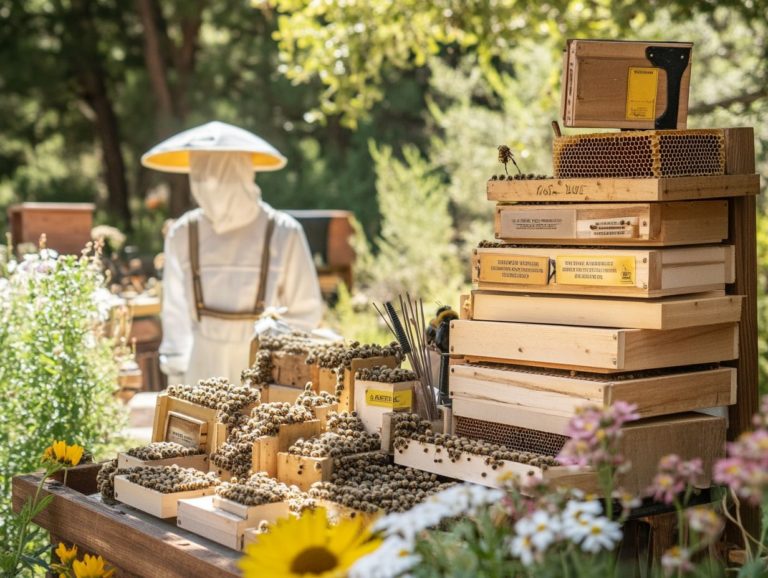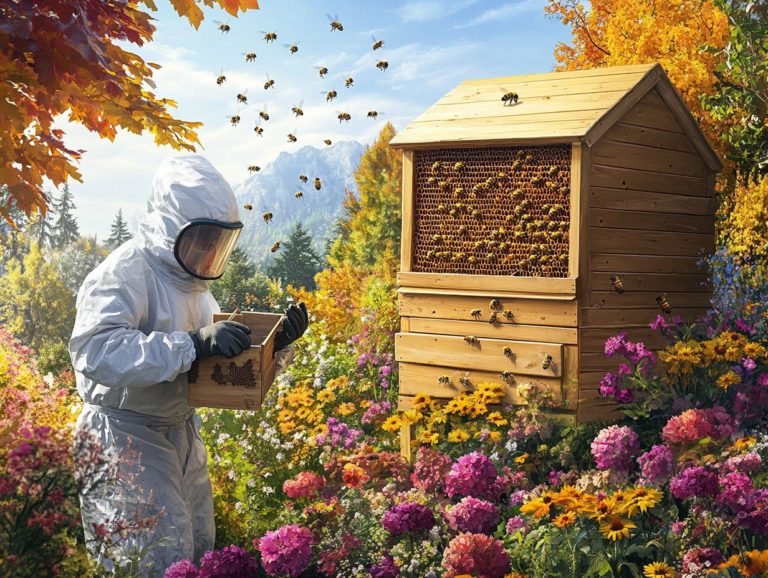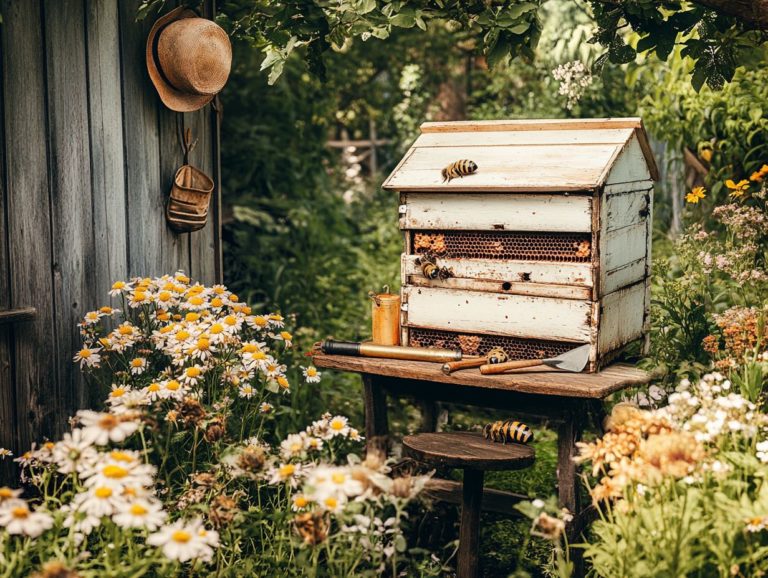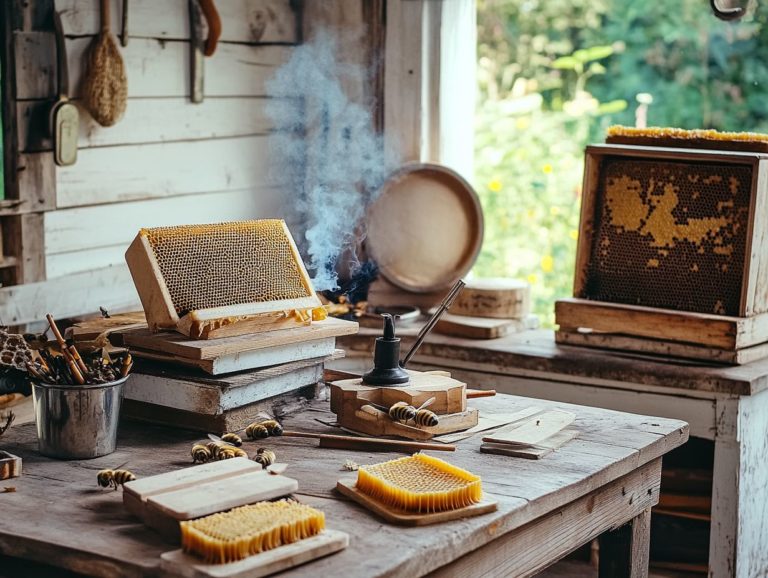Top 10 Essential Tools for Backyard Beekeeping
Backyard beekeeping is a rewarding hobby that boosts local ecosystems and offers fresh organic honey. It’s essential to choose the right tools and gather some basic knowledge to get started.
This guide will introduce you to ten must-have tools for aspiring beekeepers, from beehives to protective gear and honey extractors. You will also discover the benefits and challenges of beekeeping, along with practical tips for nurturing a thriving bee colony.
Contents
Key Takeaways:
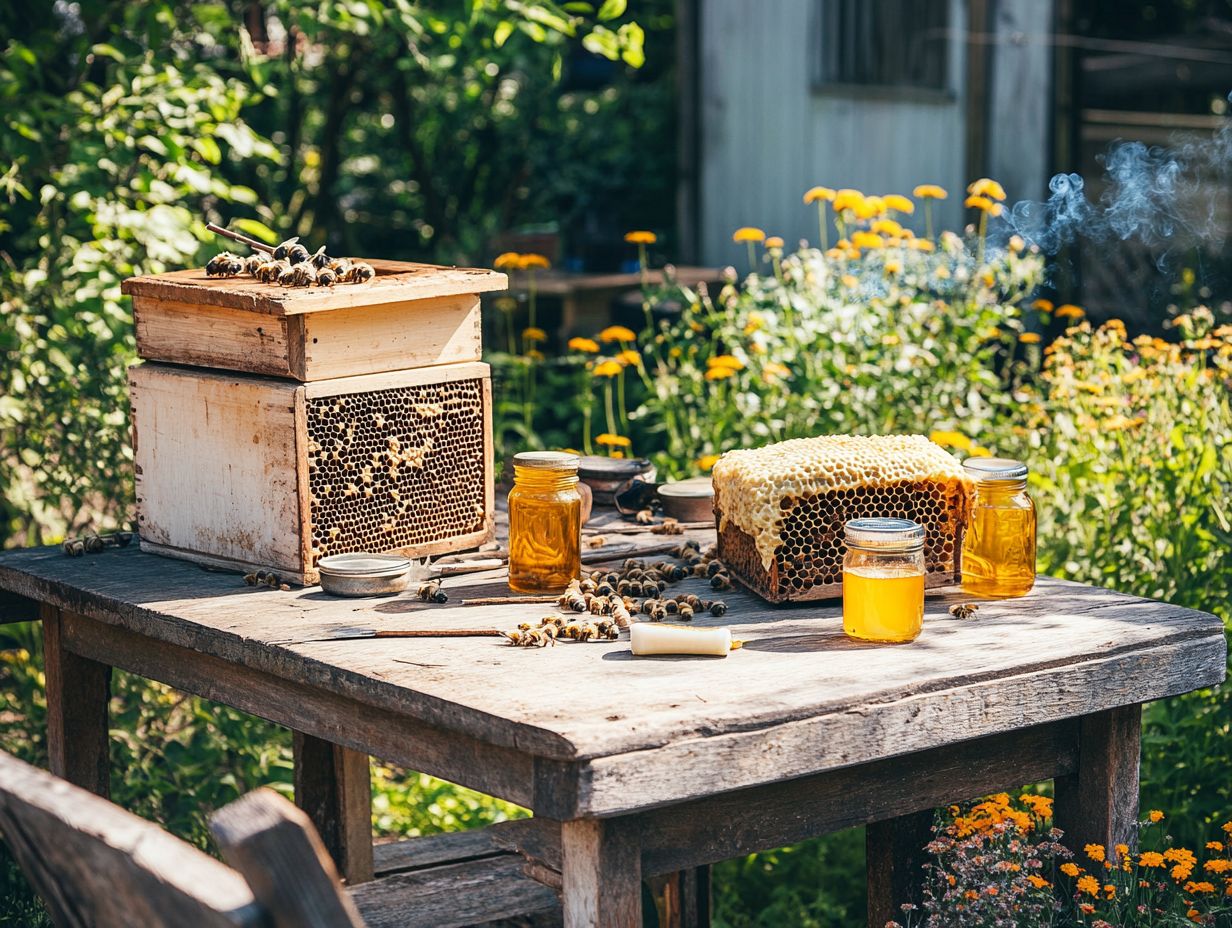
- Invest in a sturdy beehive to provide a safe and suitable home for your honey bees.
- Protect yourself with appropriate gear, including a bee suit, gloves, and a veil.
- Utilize a smoker to calm the bees and make hive inspections easier.
1. Beehive
A beehive is the essential habitat for honey bees. It provides a structured environment where their intricate social interactions and survival strategies come to life. You can choose a Langstroth hive, known for its modular design, or a top bar hive, which is appreciated for its simplicity and natural approach.
Setting up your beehive correctly is crucial for cultivating healthy colonies that thrive in your apiary an area where beehives are kept. This contributes to pollination, honey production, and overall pollinator health.
For beginners, the Langstroth hive is often the go-to choice due to its easy expansion capabilities and accessibility for inspections. This accessibility is vital for keeping an eye on hive health. In contrast, top bar hives promote a more natural management style, allowing you to observe your bees with minimal disturbance.
Regardless of which hive type you choose, effective management involves regular checks for signs of disease, pests, and sufficient food stores. This ensures your colonies remain robust. Beehives play an integral role in sustainable gardening practices by enhancing pollination, benefiting plants and local ecosystems, and ultimately promoting biodiversity and food security.
2. Protective Gear
Protective gear is essential in backyard beekeeping. It shields you from potential bee stings while you work with your bee colonies.
Selecting the right clothing is not just about safety; it’s also about ensuring your comfort. Beekeeping can be quite a workout, so opt for bee suits made of breathable materials that help regulate your temperature during warm days in the apiary.
When it comes to gloves, choose wisely aim for a balance that gives you dexterity while still providing solid protection. A well-fitted veil is vital. It offers clarity and visibility while keeping the bees at a safe distance, allowing you to focus on your tasks without unnecessary distractions.
Investing in high-quality protective gear significantly enhances your beekeeping experience. It instills confidence and empowers you to engage effectively with your bees, enabling you to truly savor the process.
3. Smoker
A smoker is a critical tool for your beekeeping supplies. It produces smoke that calms honey bees and facilitates safer hive management during inspections.
This calming effect is crucial for a smooth and safe beekeeping experience. It helps minimize the bees’ defensive behavior, allowing you to work with the hives without triggering alarm or aggression. The smoke disrupts communication pheromones among the bees, masking alarm signals and fostering a peaceful atmosphere for both you and the bees.
To use a smoker effectively, light suitable materials like dry leaves, pine needles, or shredded paper. These generate cool smoke that is less likely to harm the bees, creating a steady stream you can direct into the hive during your inspections.
4. Hive Tool
A hive tool is a versatile and essential piece of beekeeping equipment that significantly enhances your hive maintenance and inspection tasks. This makes your beekeeping experience much more efficient. It is one of the most crucial beekeeping supplies you will need.
Each type of hive tool serves its own unique purpose, tailored to specific aspects of your beekeeping journey. For example, a pry bar is invaluable for opening the hive without causing undue disturbance to the bees. This ensures a smoother inspection process.
A scraper tool comes in handy for removing propolis, a sticky substance made by bees to seal gaps in the hive, and other residues. This keeps your hive clean and supportive of the colony s health.
Meanwhile, bee brushes allow you to gently sweep bees off frames during honey extraction, minimizing any stress on these industrious insects. An uncapping tool is crucial during honey extraction as it carefully removes wax caps from the honeycomb.
Together, these tools streamline your colony management and empower you to monitor your hives effectively. They promote overall health and allow you to harvest honey with remarkable ease.
5. Queen Excluder
A queen excluder is a specialized device in your beekeeping toolkit designed to keep the queen bee out of certain areas of the hive. This is essential for effective hive management.
By limiting the queen’s movement, this tool is vital for maintaining the colony’s structure and organization. It allows worker bees to occupy designated honey storage areas. This ensures the queen can concentrate on laying eggs in the brood chamber without any distractions.
This practice is common among both hobbyist and professional beekeepers within the beekeeping community. This separation enhances honey production, allowing you to harvest surplus honey with a reduced risk of contamination from the brood.
By controlling where the queen lays her eggs, you can cultivate stronger, healthier colonies, ultimately leading to more productive hives.
6. Honey Extractor
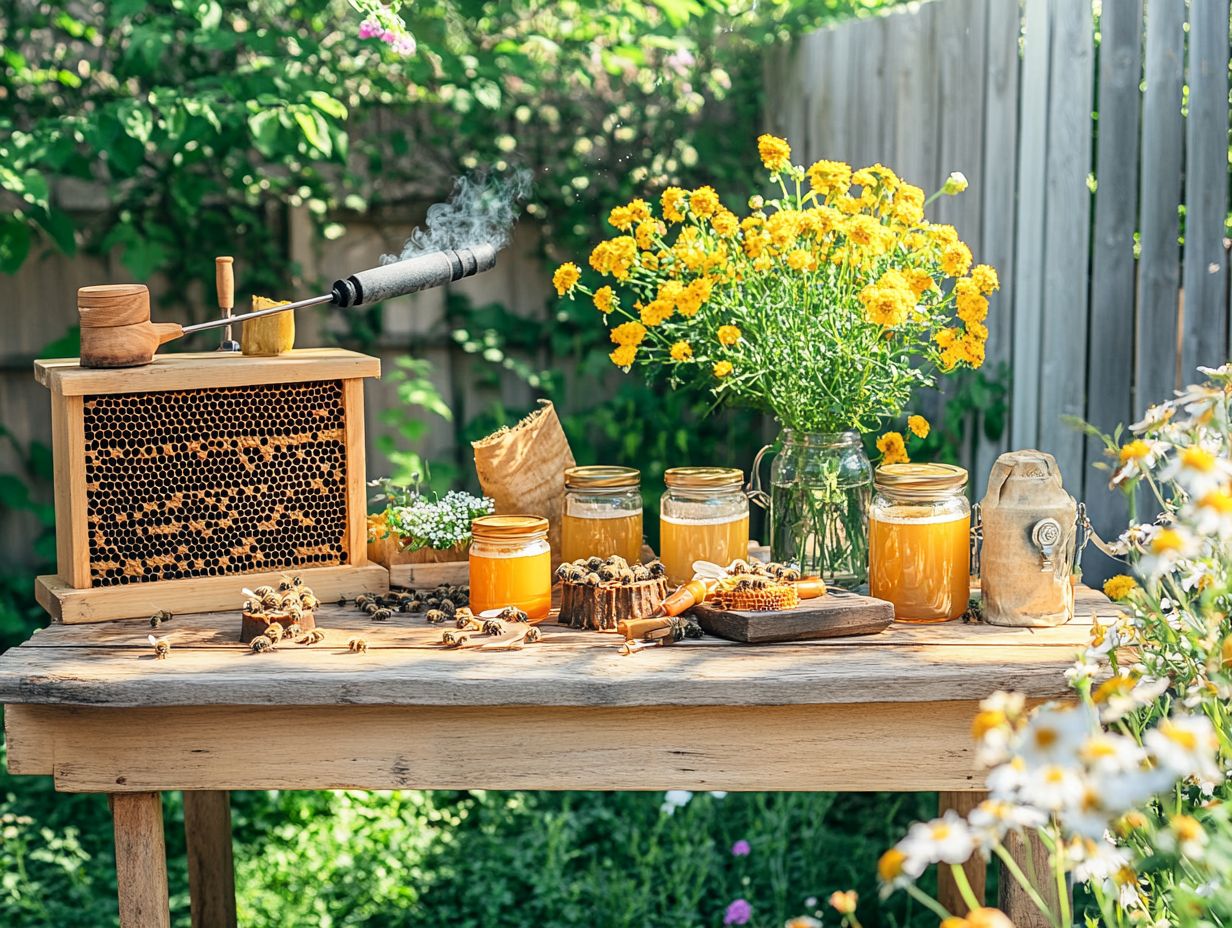
Get ready to unleash the golden goodness with a honey extractor! This indispensable tool transforms honey extraction into an exciting and efficient process by extracting honey from the honeycomb while preserving the integrity of the comb itself. This careful extraction process is crucial for maximizing your honey production.
You have two primary options when it comes to extractors: manual and electric. Manual extractors, often preferred by hobbyists or those tending smaller apiaries, require a bit of physical effort. You’ll find yourself turning a hand crank to spin the frames, harnessing centrifugal force to extract the honey.
In contrast, electric extractors offer a more efficient and less labor-intensive approach. With motorized systems at your disposal, you can process larger quantities of honeycomb quickly and effortlessly.
Whichever type you decide to use, it s vital to adhere to best practices during honey extraction. Work during the cooler parts of the day to minimize stress on the bees. Always prioritize the integrity of the hive. This attention to detail promotes the health of your colony and ensures its productivity for future honey harvests.
7. Honey Jars and Labels
Choosing the perfect honey jar is a game-changer for your business! Honey jars and labels are not merely packaging; they serve as essential elements in the marketing and presentation of organic honey, elevating its appeal and highlighting its distinctive benefits.
When you re choosing jars for honey, it s important to consider not just how they look but also their functionality. The right container will preserve the honey s natural properties while ensuring it catches the eye on store shelves.
Creative labeling can amplify this allure by showcasing unique attributes, such as rich phytonutrients and local pollen sources that set it apart from mass-produced alternatives. A thoughtfully designed label isn t just decorative it tells a story about the honey s origin, fostering a personal connection with consumers.
It emphasizes the care taken in its production, opening the door for conversations about sustainability and quality.
8. Bee Brush
A bee brush is an essential tool in your beekeeping arsenal. It is designed specifically to gently remove bees from frames and other surfaces.
This tool ensures safe handling during your hive inspections and is one of the most frequently used items in your beekeeping supplies.
With its soft bristles, this tool enables you to delicately sweep away bees without causing them harm. The key is to employ a light touch, using a gentle sweeping motion rather than a forceful push.
This approach significantly reduces stress on the insects. It not only keeps the bees safe but also creates a peaceful atmosphere in the hive. Maintaining tranquility is vital since a stressed hive may exhibit defensive behaviors, disrupting productivity and compromising colony health.
Ultimately, wielding a bee brush with finesse fosters a more harmonious environment, making your inspections and hive management easier and more effective.
9. Feeder
A feeder is a critical tool for your backyard beekeeping endeavors, offering essential nourishment to honey bees, particularly during times when flowers aren t producing much nectar or when you’re establishing a new colony in your apiary.
You ll find an array of feeder types at your disposal, each tailored for specific purposes and management practices. For instance, entrance feeders allow honey bees to access food directly from the hive entrance, minimizing disturbances during their busy routines.
On the other hand, top feeders boast larger capacities, keeping the feed out of the way of the bees’ primary activity areas. Whether you prefer a Langstroth hive or a top bar hive, choosing the right feeder can significantly impact your colony management.
To ensure the health and vitality of your hive, it’s vital to check the feeder regularly, making certain it’s filled with the appropriate blend of sugar syrup or pollen substitute. By positioning feeders thoughtfully, you can reduce competition among your bees and enhance foraging efficiency.
Consider using different pollen sources to provide your bees with all the nutrients they need, ultimately fostering a more resilient and productive bee colony.
10. Uncapping Knife
An uncapping knife is an essential tool in your honey extraction arsenal, enabling you to effortlessly remove the wax caps from honeycomb cells and streamline your honey harvest. This tool, along with other essential beekeeping equipment like the smoker and hive tool, makes the process of harvesting organic honey more efficient.
You ll find a variety of uncapping knives available, including electric, hot water, and manual models. Each is tailored to different preferences and scales of honey production.
Electric knives heat up quickly and maintain a consistent cutting temperature, making them perfect for larger operations where efficiency reigns supreme. In contrast, hot water knives rely on a water bath to stay effective, while manual uncapping knives offer a more traditional approach, ideal for hobbyists or small-scale beekeepers.
To maximize your honey yield, make sure your uncapping knife is hot and ready. This simple step can save you time and boost the amount of honey you extract from the frames.
What Is Backyard Beekeeping and How Does It Work?
Backyard beekeeping is the art of nurturing one or more beehives right in your own backyard, allowing you to engage directly with honey bees while making a meaningful contribution to pollinator health and honey production. This fulfilling hobby not only champions sustainable living but also empowers you to cultivate a thriving environment for bee colonies within your apiary. By mastering proper colony management and understanding the nuances of bee behavior, you unlock the rewards of organic honey while supporting local ecosystems. Beekeeping classes can help you get started, providing foundational knowledge and best practices.
To embark on this exciting journey, begin by choosing an ideal location for your hives somewhere sheltered from harsh winds, basking in sunlight, and conveniently close to flowering plants. A well-thought-out beehive setup can make all the difference in maintaining a healthy and productive hive.
It’s essential to familiarize yourself with local beekeeping laws, as certain areas may impose specific regulations regarding hive placement and maintenance practices, ensuring that both your bees and your neighbors can coexist harmoniously. Joining local beekeeping organizations can provide valuable insights and updates on these laws.
Investing in key equipment will set you up for success in home beekeeping. Make sure to gather essentials like:
- Hive body
- Frames
- Beeswax foundation
- Protective gear
- Tools like a smoker and hive tool
With these foundational elements in place, you can cultivate a vibrant apiary that offers sweet rewards and plays a crucial role in the ecosystem.
What Are the Benefits of Backyard Beekeeping?
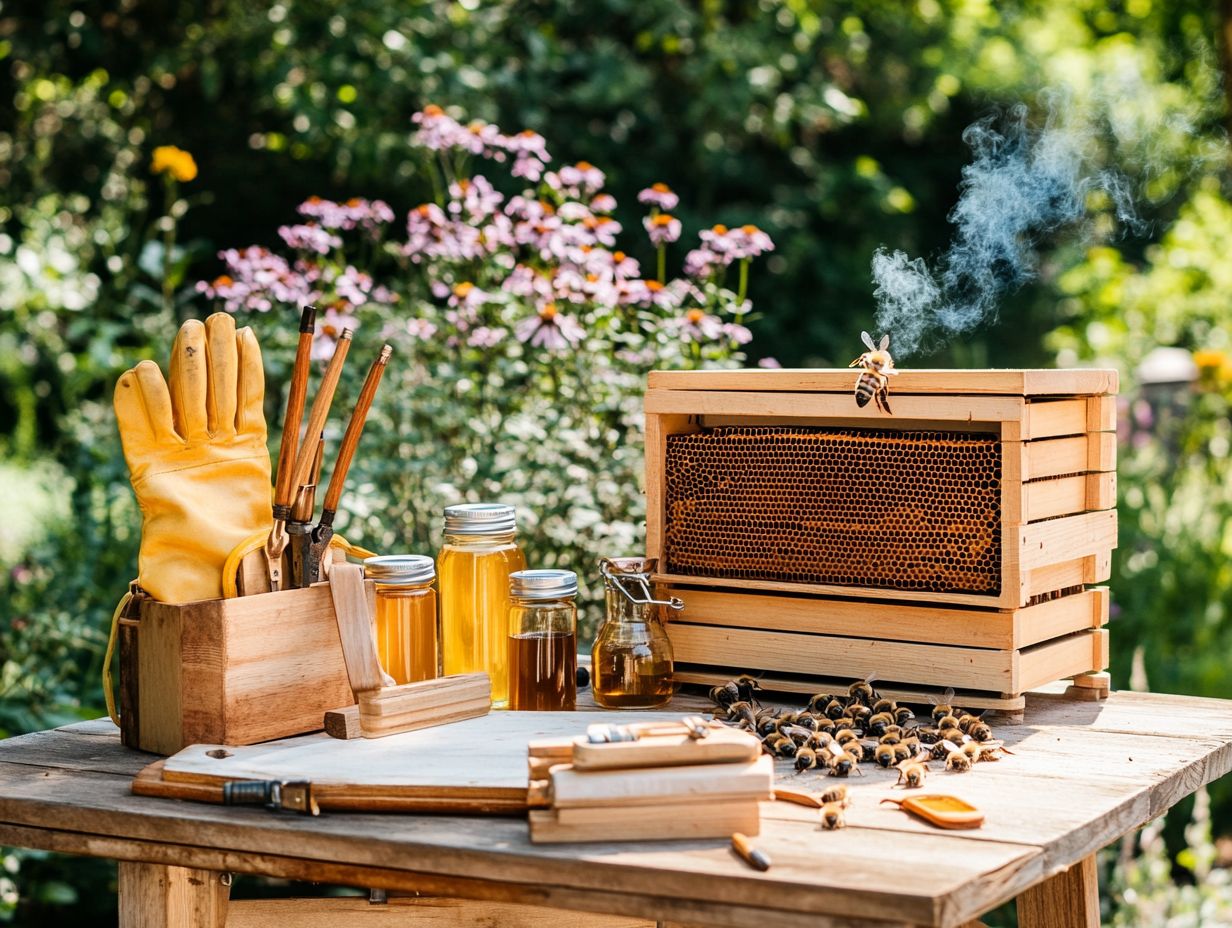
Backyard beekeeping presents a wealth of advantages, from boosting honey production to enhancing pollination for your garden and the surrounding ecosystem. It allows you to harvest organic honey that s rich in phytonutrients, elevating your culinary delights.
Not only does this practice support the health of local pollinators, but it also plays a vital role in enhancing biodiversity in your area. By attracting bees to your garden, you ll witness the remarkable transformation of your plants, as vibrant blossoms and bountiful fruits emerge, all thanks to more effective pollination.
The satisfaction of producing your own homemade honey is unparalleled; it’s a delightful reward for your efforts while also ensuring a sustainable food source. When you embrace sustainable gardening methods, like companion planting or organic pest control, you can cultivate a thriving green space that nurtures both your plants and pollinators, fostering a harmonious relationship that benefits the entire ecosystem. Additionally, incorporating honey recipes into your daily life can bring a sweet touch to your diet, rich in honey s natural phytonutrients.
What Are the Challenges of Backyard Beekeeping?
Backyard beekeeping is undoubtedly rewarding, but it does present its own set of challenges. You ll find yourself navigating bee stings, battling pests like Varroa mites, and mastering the art of effective colony management. Ensuring you have the right beekeeping supplies can make a significant difference in overcoming these challenges.
As a beginner beekeeper, you might struggle to grasp how seasonal changes impact your bees behavior. For example, as the temperatures shift throughout the year, your bees will become less active in the colder months, which can affect both honey production and the overall health of your colony. Understanding the life cycles of honey bees can offer insights into their seasonal behaviors.
To tackle these challenges, it s crucial for you to monitor hive temperatures and protect your colonies from extreme weather with insulation and thoughtfully designed hives. By keeping a vigilant eye on their food stores and ensuring that your bees have enough supplies for winter, you can significantly boost their survival rates. This makes beekeeping not just a labor of love, but a sustainable and fulfilling endeavor.
How Can One Get Started with Backyard Beekeeping?
Starting backyard beekeeping involves several essential steps, including enrolling in beekeeping classes, gathering the necessary equipment, and selecting a healthy nucleus (nuc) colony to establish your hive. Whether you choose a traditional Langstroth hive or a top bar hive, selecting the right beehive setup is crucial for success.
For beginners, researching local beekeeping organizations is crucial. These groups provide invaluable resources, guidance, and a supportive community. They can connect you with experienced mentors who help you navigate hive management with ease. Familiarizing yourself with beekeeping tips from seasoned beekeepers can also be very helpful.
Selecting the right beehive setup that aligns with your local climate and available space is equally important, as different configurations offer distinct advantages. Understanding the life cycles of honey bees empowers you to cultivate productive hives and sustain healthy bee populations, giving you deeper insights into their needs and behaviors throughout the seasons. Engaging with a beekeeping community provides practical advice and shared experiences.
What Are the Common Mistakes to Avoid in Backyard Beekeeping?
As a beginner beekeeper, you might encounter common traps that could hinder your colonies’ success. Neglecting hive maintenance, misjudging nectar flow, or adopting improper beekeeping practices are pitfalls to avoid.
These oversights can lead to weakened hives, reduced honey production, and even colony failures. Make regular inspections your priority to keep your hives thriving! Recognizing the signs of a healthy hive and adapting your techniques according to seasonal shifts is essential.
Enhancing your knowledge through books, workshops, and local beekeeping clubs can significantly boost your understanding and skills. Keeping meticulous records of hive activity and nectar availability empowers you to make informed decisions that align with your colony’s needs and the local environment. Following best practices in hive maintenance leads to more resilient and productive hives.
By cultivating a mindset of continuous learning, you will foster resilience and mastery on your beekeeping journey.
How Can One Maintain a Healthy Bee Colony in Their Backyard?
Maintaining a healthy bee colony in your backyard demands attention and dedication to consistent monitoring and a keen understanding of their habitat needs and effective colony management strategies.
To ensure the well-being of these essential pollinators, conduct regular hive inspections. This practice allows you to spot potential issues early on, preventing them from escalating. Providing adequate nutrition is critical; this involves offering diverse forage sources and supplemental feeding during lean times. Seasonal adjustments in hive maintenance also play a significant role in maintaining a healthy bee colony.
Creating a supportive environment involves minimizing pesticide use and actively fostering biodiversity in your garden. Be attuned to signs of stress in your bees, such as a noticeable drop in activity at the hive entrance or unusual behaviors. Remain vigilant for indicators of disease like chalkbrood or Varroa mite infestations. Recognizing these signals early can be pivotal in nurturing a thriving bee community.
Frequently Asked Questions
What are the top 10 essential tools for backyard beekeeping?
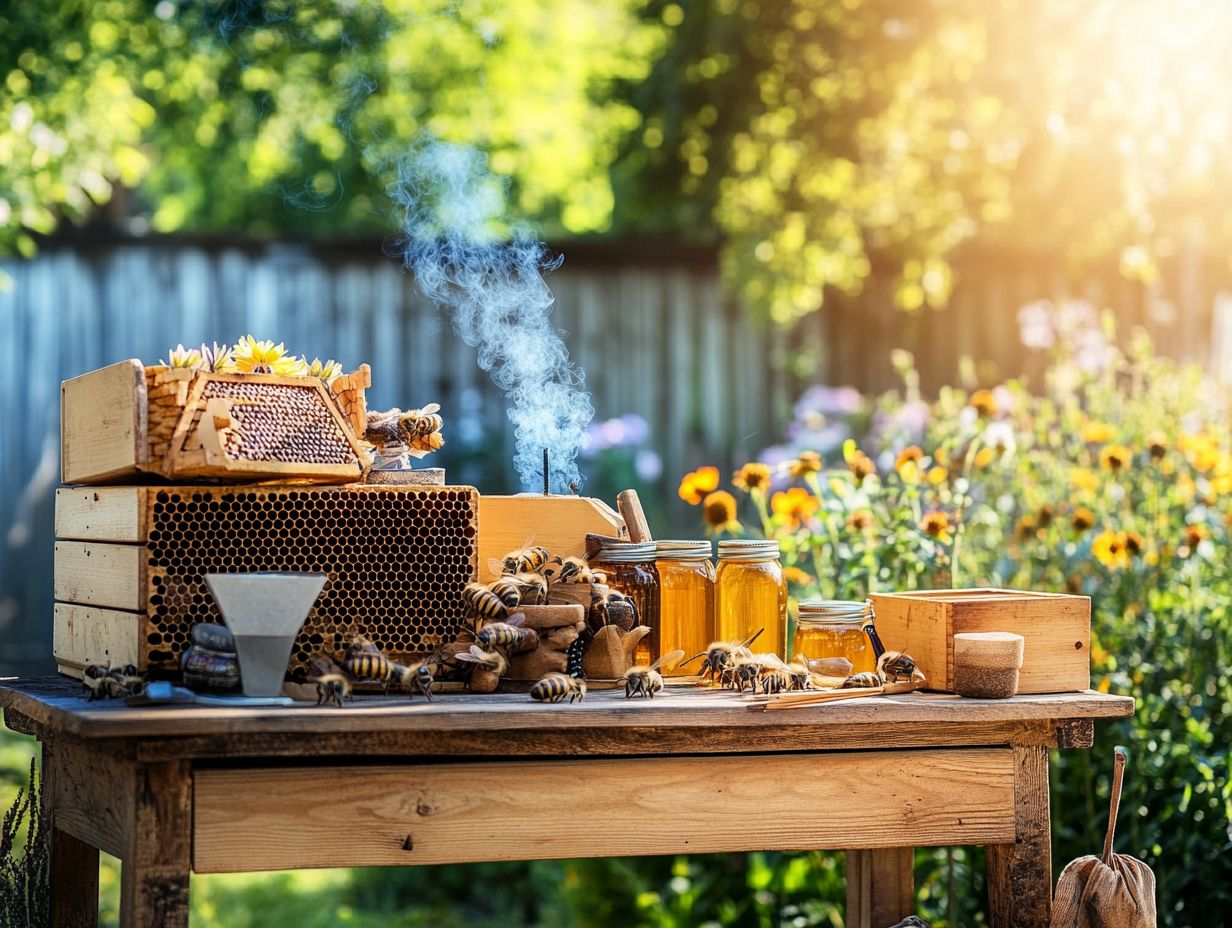
The top 10 essential tools for backyard beekeeping are: hive tool, smoker, bee brush, frame grip, bee veil, beekeeping suit, honey extractor, uncapping knife, hive stand, and feeder. These tools are vital for ensuring efficient and effective beekeeping.
Ready to start your beekeeping adventure? Gather these top beekeeping tools for efficiency today!
Do I need all of these tools for backyard beekeeping?
No, you do not necessarily need all of these tools for backyard beekeeping. However, these tools are highly recommended for a successful and efficient beekeeping experience. Investing in quality beekeeping supplies can significantly enhance your beekeeping journey.
What is a hive tool?
A hive tool is a multipurpose tool used for opening beehives, separating frames, and scraping off propolis and wax. It is one of the most important tools in your beekeeping supplies.
Why do I need a smoker for beekeeping?
A smoker is used to calm the bees during hive inspections. This makes it easier to work with the hive and reduces the risk of getting stung. Proper use of a smoker is very important in beekeeping.
How do I use a bee brush?
A bee brush is a must-have tool for every beekeeper! It gently sweeps bees off the frames during hive inspections.
Using a gentle touch is key to avoiding harm to the bees. Using a hive tool and wearing protective gear also enhances safety and efficiency.
What is a honey extractor in beekeeping?
A honey extractor is a crucial piece of beekeeping equipment used in the honey extraction process. It extracts organic honey from the honeycomb by spinning the frames to remove the honey without damaging the comb.
Before placing the frames in the extractor, beekeepers often use an uncapping tool, which removes the wax caps from honeycomb cells. Honey extractors are commonly found in an apiary, especially for those who follow sustainable living practices.
Consider investing in a honey extractor to elevate your beekeeping journey!

